#prince of wales/prinz eugen
Link
Chapters: 1/1
Fandom: 碧蓝航线 | Azur Lane (Video Game)
Rating: Teen And Up Audiences
Warnings: No Archive Warnings Apply
Relationships: Prince of Wales/Prinz Eugen (Azur Lane)
Characters: Prince of Wales (Azur Lane), Prinz Eugen (Azur Lane)
Additional Tags: Ballroom Dancing, Suits, False Identity, Secret Identity, except they aren't really a secret, Dialogue Heavy, Banter
Series: Part 7 of femslash feb 2024
Summary:
Prinz Eugen is alone at a Royal gala, but a handsome stranger might just change that.
#fanfiction#femslashfeb2024#kms prinz eugen#hms prince of wales#prince of wales/prinz eugen#minifemslashfeb2024
2 notes
·
View notes
Text

Prinz Eugen x PoW Doodle
Tweet
Pixiv Post
#Azur Lane#Prince of Wales#Prinz Eugen#プリンス・オブ・ウェールズ#プリンツ・オイゲン#アズールレーン#アズレン#碧蓝航线#art#rkgk#fanart#yuri
71 notes
·
View notes
Text
Prince of Wales, [to Prinz Eugen]: When I said I wanted you to make noise during sex, I didn’t mean mocking ones.
#prinz eugen#unluckiest lucky ship#kreuzer prinz eugen#hms prince of wales#prince of wales#lady in the streets lady in the sheets#denmark not straights#rivalry is a fun game#azur lane#incorrect azur lane quotes#incorrect azur lane quote#incorrect azur lane#incorrect quote#incorrect quotes#source: unknown
25 notes
·
View notes
Text

The heavy cruiser Prinz Eugen. Kinda makes me sad, she really was beautiful, and had much potential. But she only scored a couple hits on HMS Prince of Wales and ran into a fellow German warship. Lost her running mate Bismarck too. Bummer.
#vw bus#history#ww2 art#ww2#wwii#warship#wwii art#art#artwork#warbird#fighter#prinz eugen#heavy cruiser
7 notes
·
View notes
Text
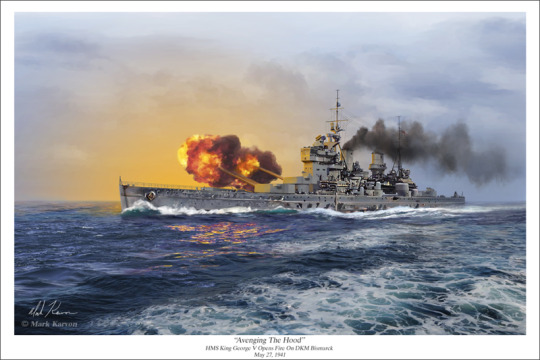
"Avenging The Hood" by Mark Karvon, link.
"One of the most feared ships during World War II was the German battleship Bismarck. In May 1941, the Bismarck managed to sneak out of port with the cruiser Prinz Eugen. British naval units were tasked with finding the Bismarck and on May 24 the HMS Hood, known as the pride of the British fleet, along with the HMS Price of Wales caught up with the two German raiders in the Denmark Straight. After a short exchange of fire the Hood’s armor was pierced by a shell from the Bismarck and detonated in the aft magazine. The resulting explosion broke the ship’s back and she quickly sank leaving only three survivors. Prince of Wales retreated, heavily damaged.
The loss of the Hood was a great shock to the nation and the pursuit of the Bismarck became top priority for the British fleet. On May 26 the Bismarck was struck by a torpedo from a British Swordfish aircraft. The hit disabled her rudder and it became almost impossible to steer the ship.
Having damaged their quarry, the British fleet closed in for the kill. On the morning of May 27 the fleet lead by the battleships HMS King George V and HMS Rodney sighted the Bismarck and opened fire. The Bismarck was sunk in a battle lasting approximately 2 hours. The Hood was avenged.
This print depicts HMS King George V the moment she opened fire on Bismarck."
#HMS King George V#King George V Class#Battleship#May#1941#Royal Navy#World War II#World War 2#WWII#WW2#painting#my post
27 notes
·
View notes
Text
The Pursuit of the Bismarck, 24–27 May 1940
Ludovic Kennedy wrote multiple accounts of his experience of these events, including in books called Sub-Lieutenant (1942) and Pursuit: The Chase and Sinking of the "Bismarck" (1974). I believe this one (transcribed into American English) precedes both. The writing is pretty good and there are a lot of interesting aspects to consider.
—
I had the first watch that May evening, a day out from the Clyde. With Somali, Eskimo and Mashona we were escorting the troopship Britannic and the battleship Rodney westward across the Atlantic. It was, as I recall, an uneventful watch, and at about 9 p.m. while checking bearings and distance from Rodney for perhaps the sixth time, I heard the buzzer from the wireless office. Signalman Pearson, with whom I was sharing the watch, a barrel-shaped fellow partial to chocolate “nutty,” thrust his flabby fist into the voicepipe and hauled up the signal box.
"U-boat Disposition Report, I expect," he said.
He unraveled the signal, scanned it, then handed it to me. It was prefixed MOST IMMEDIATE, came from the cruiser Norfolk and went something like this: IBS ICR 66.40N 28.22W Co220 Sp 30.
“Pearson,” I said, "does that mean what I think it means?”
"Yes, sir. One enemy battleship, one enemy cruiser, position sixty-six forty North, twenty-eight twenty-two West, course 220, speed 30 knots.”
"Christ!" I said, and pressed the captain's buzzer.
In such a manner did I learn of the break-out into the Atlantic of the giant Bismarck together with the Prinz Eugen, an event followed by the most exciting week of my life. A glance at the chart showed that the German ships had been picked up in the Denmark Strait, the stretch of water that lies between Greenland and the north of Iceland. Although of intense interest the news did not then affect us personally, as we were 600 miles away and fully occupied with protecting Rodney and Britannic against U-boats. But it was the one topic of conversation throughout the ship. In the wardroom that night we discussed the likely eventualities into the early hours, and when my servant called me with tea at 7.30 next morning, I was already awake.
"Heard the news, sir?”
“No.”
"Hood's gone.
“No!"
"Yes, and Prince of Wales damaged.”
The Hood gone - the most famous, most loved of British warships, the one above all others that epitomized the Navy and the country? It seemed impossible to believe. And the brand new Prince of Wales damaged? If this is what the Bismarck could do in six minutes flat, what might she not achieve against the convoys from America? The question-mark that had arisen at the time of Dunkirk rose again. Loose in the Atlantic and supported by supply ships and tankers, she could prey on our shipping for months and cut the supply line on which we depended for survival.
After breakfast I went to the charthouse where Spider had put up a large scale chart of the Atlantic, and penciled on it the position of the first sighting of the German squadron, the location of the sinking of Hood, and the squadron's present position as received from the signals of the pursing Norfolk, Suffolk and wounded Prince of Wales. He had also marked the positions of the British ships closing in on Bismarck, and as the day passed and assuming she kept her present course and speed, it looked as though the commander-in-chief, Admiral Tovey, in his flagship King George V with the battlecruiser Repulse would be the first to engage her in the morning and (if the result was inconclusive) that we would be the second.
Eskimo and Britannic went off to the west, while we steamed southwestward all day, the seas getting higher, the wind rising hourly. Inevitably that evening, as the gap between us gradually narrowed, one's thoughts turned to the action that lay ahead. Inevitably too one had mixed feelings, partly a desire to stop the Bismarck at all costs and by so doing perhaps win honor and glory, partly—and I'm not sure if it wasn't the stronger part—a reluctance to get embroiled at all. Our task, if we met, was to close in to some 6000 yards to deliver our four torpedoes. With Rodney soon outdistanced by the swifter enemy, we would have to undergo the full weight of his broadsides during the run-in; and we knew, without having to say it, that if we survived that, it would be a miracle.
When I came on watch again at midnight, it was blowing a gale, We had to reduce speed to 15 knots, while Rodney with her long dachshund’s snout pushing through the crests had lumbered past at her maximum 22 knots and was now out of sight ahead. I think that was the most uncomfortable watch I ever kept. The motion was like that of a hovercraft in a bumpy sea, greatly magnified, for we lunged at the waves rather than rode them. Throughout the watch the signals from the shadowers kept coming in, and it looked as though the commander-in-chief would make contact with the enemy at around noon. When I reached my cabin via the engine-room and boiler-room (for there was a danger of being washed overboard along the upper deck) I found the place a shambles—books, wireless and broken water carafe strewn about the deck. I left them where they were and clambered into bed.
“Sir?”
Where was I?
“Seven-thirty. Here’s your tea. I’ve cleaned up the mess on the deck. And Jerry’s done a bunk.”
I thought sleepily, this man has got his priorities right.
“Lost contact, have we?”
“Not a whisper since you came off watch. Can’t say I’m altogether sorry.”
This is not the place to recount the changing events and fortunes of either side during the rest of the operation, for we had little knowledge of them at the time … Suffice it to say that two days later when we had begun to think that Bismarck had disappeared off the face of the waters, she was spotted alone (for she had detached Prinz Eugen for independent warfare) some 700 miles north-west of Brest. Her speed was down to 20 knots which suggested damage or a fuel problem (it was both) but which would bring her under German air cover within twenty-four hours. At that time Rodney, Tartar and Mashona (Somali had left us to refuel) were still bucketing around the ocean at high speed, but we were some 150 miles to the north of her, and with only a couple of knots' advantage had virtually no chance of catching up.
There was still however one British group between Bismarck and France, Vice-Admiral Somerville’s Force H. Steaming north from Gibraltar; it included the aircraft-carrier Ark Royal, and if one of her torpedo-planes could slow down Bismarck a little more, there might still be a faint chance of bringing her to book. At six that evening Admiral Tovey in King George V thundered over the horizon to join us, and took station in the van. Presently a signal lamp began flashing from the flagship’s bridge. “To Rodney,” sang out our signalman, “from C-in-C. What is your best speed?”
Then it was Rodney's turn.
"To C-in-C. From Rodney. Twenty-two knots.”
Gradually the distance between the two ships lengthened and Rodney's lamp began flashing again.
"To C-in-C," shouted the signalman, "from Rodney. I am afraid that your twenty two knots is taster than mine.”
The flagship dropped back, and we all steamed on, less with any real hope of Bismarck being delivered to us than for the lack of any alternative; if failure had to be admitted, let it not be admitted until the last possible moment. At 6.30 p.m. Tovey signalled the Admiralty that unless Bismarck's speed had been reduced by midnight, King George V would have to return to harbor for lack of fuel; Rodney, with Tartar and Mashona also very short of fuel, could continue until eight the next morning. A little later came a report from Admiral Somerville that he had launched a torpedo attack with Swordfish aircraft, but they had registered no hits: if the light held, he aimed to launch another. For two hours we waited in anticipation of this, praying, hoping that it might be successful. Then came a second signal:”
“Attack completed. Estimate no hits.”
So that was it. The long week's night was over: we had lost Hood and gained nothing in exchange, and Bismarck was freed to fight another day. In Rodney the captain told the crew over the public address system that their last chance of bringing the enemy to action had gone, and his commander ordered guns' crews to stand down. As for Tartar, it is difficult to convey the extent of the gloom in which we sat down to supper in the wardroom; nor, now that the week-long tension had been broken and the banging and buffeting were almost over, the overwhelming sense or exhaustion we all felt.
And then a most extraordinary thing happened. A signal was received from the cruiser Sheffield, shadowing Bismarck from astern: “Enemy’s course 340°.” Now 340° was almost due north, toward us, almost the opposite of the course of around 120° which she had been steering for Brest. On the bridge the general feeling was that the captain of the Sheffield must have made a mistake and thought Bismarck was steaming from right to left instead of left to right, understandable enough in the prevailing weather. But a few minutes later came a confirmatory signal, “Enemy’s course North,” and when further signals came in saying her speed was no more than a few knots, we all realized that Bismarck had been crippled by the last Swordfish attack (one torpedo had hit and jammed her rudder) and that she was going to be delivered to us after all.
So we made preparations for a battle which—unless Bismarck was able to slip away in the night—now looked inevitable; I stowed away all things breakable in my cabin, put on clean underwear and filled the brandy flask, mounted to my action station at the pom-pom, and wondered how it might be when the time came.
And then an odd thing occurred. An army officer, what the Navy calls a pongo, had come aboard when we first sailed as a wardroom guest; he had been given a week's leave, was hoping for a spot of sea breezes, had not thought to get involved in this. After dinner, not knowing the rules and having nothing to do, he had got rather tipsy, and now he appeared on the upper deck singing to the wild night his repertoire of pongo songs. When it was reported to the captain, he was ordered to go to his cabin and stay there. In former times, I suppose, he would have been clapped in irons or shot.
The weather worsened as the night wore on. The same head-wind into which Bismarck had involuntarily turned gave us a following sea; one in which the bows yawed sideways like a car in a skid, so that the ship leaned heavily to starboard and stayed there like a determined drunk until the quartermaster gradually eased here back to the given course. All night long we stayed at action stations while the ship slewed first one way and then the other and great rafts of spray, flung up from the bows, slapped at our oilskins and sou'westers. At first I had turned over in my mind what our role might be—perhaps a night torpedo attack—but soon anything beyond the next five or ten minutes seemed remote and irrelevant. After what felt like an eternity dawn came, with curling wave-tops, a leaden sky, wretched visibility. Presently the commander-in-chief sent a signal asking Tartar and Mashona their fuel situation. When he had been told, he sent another signal:
“On receipt of executive signal, proceed as convenient to refuel at Plymouth or Londonderry.”
Were we not going to be allowed to be in at the kill?
During the morning watch guns crews were allowed to go off in ones and twos for breakfast, and around 8 a.m. I went down to the wardroom for mine. Returning, saw that Rodney and King George V had drawn well ahead of us, so popped up to the bridge for the latest news. There I found long faces and silence. I looked at the Yeoman of Signals quizzically and he handed me the signal log. “Tartar and Mashona from C-in-C,” I read. “Proceed in execution of previous orders.” So, thanks to our critical fuel situation (for if ordered in to a torpedo attack at speed, we would use up a great deal more), we were to be denied any part in the battle. But Tovey’s original signal had said to proceed to refuel as convenient—“and what I’m going to find convenient,” said the captain, “is to stick around for a bit and watch.” I had reason for disappointment too. I had with me both my grandmother’s Kodak and also a 16-millimeter Bell and Howell movie camera lent to me by the father of a girlfriend; and with the pom-pom gun having no role to play, I could, had we been sent in on a torpedo attack, have obtained some unique footage.
A moment later I saw a big puff of cordite smoke about Rodney’s main armament and a second later heard the thud of her guns. Through my binoculars I saw in the distance, on the edge of a patch of rainfall, the dull smudge of a ship. There she was at last, the vessel that these past six days had filled our waking thoughts, been the very marrow of our lives. And, as the rain faded, what a ship! Broad in the beam, with long raked bow and formidable superstructure, two twin 15-inch gun turrets forward, two aft, symmetrical, massive, elegant, she was the largest, most handsome warship I, or any of us, had ever seen, a tribute to the skills of German shipbuilding. Now there came flashes from her guns and those of King George V. The final battle had begun.
In all my life I doubt if I will remember another hour as vividly as that one. It was the color contrasts I recall most, so rare in the eternal grayness of voyaging at sea. The sun appeared for the first time in days, shining from a blue sky between white, racing clouds; and the wind, still strong, was marbling and stippling the green water, creaming the tops of the short, high seas. There was the somber blackness of Bismarck and the gray of the British ships, the orange flashes of the guns, the brown of the cordite smoke, shell splashes tall as houses, white as shrouds.
It was a lovely sight to begin with, wild, majestic as one of our officers called it, almost too clean for the matter in hand. It seemed strange to think that within those three battleships were five thousand men; it seemed almost irrelevant, for this was a contest between ships not men. And who was going to win? None of us had any illusions about the devastating accuracy of Bismarck's gunfire. She had sunk Hood with her fifth salvo, badly damaged Prince of Wales, straddled Sheffield and killed some of her crew the evening before, and hit an attacking destroyer in the course of the previous pitch-black night. But there were factors we had not reckoned with: the sheer exhaustion of her crew who had been at action stations for the past week, the knowledge as they waited through that long, last dreadful night that the British Navy was on its way to exact a terrible revenge, that they were virtually a sitting target.
Rodney was straddled with an early salvo but not hit, then with her fire divided, Bismarck’s gunnery sharply fell off. But that of Rodney and King George V steadily improved. As they moved in ever closer, we observed hit after hit. The hydraulic power that served the foremost turret must have been knocked out early, for the two guns were drooping downward at maximum depression, like dead flowers. The back of the next turret was blown over the side and one of its guns, like a giant finger, pointed drunkenly at the sky. A gun barrel in one of the two after turrets had burst, leaving it like the stub of a peeled banana. The main director tower had been smashed in and part of the foremost was in shreds. Through holes in the superstructure and hull we could see flames flickering in half a dozen places. But still her flag flew; still, despite that fearful punishment, she continued, though now fitfully, to fire.
It was not a pretty sight. Bismarck was a menace that had to be destroyed, a dragon that would have severed the arteries that kept Britain alive. And yet to see her now, this beautiful ship, surrounded by enemies on all sides, hopelessly outgunned and outmaneuvered, being slowly battered to a wreck, filled one with awe and pity. As Tovey said in his dispatch: "She put up a most gallant fight against impossible odds, worthy of the old days of the Imperial German Navy.” And George Whalley, our Canadian lieutenant, wrote, "What that ship was like inside did not bear thinking of; her guns smashed, the ship full of fire, her people hurt; and surely all men are much the same when hurt.” It was a thought shared by many British sailors that day, yet one rarely expressed by airmen who incinerate cities or by soldiers of those they kill in tanks. By 10 a.m. the last of Bismarck's guns had fallen silent. She was still making headway through the water, though now listing heavily to port. The fires had spread and now smoke was issuing from a hundred cracks and crevices in the deck. And then, as we looked at this silent, deadweight shambles of a ship, we saw for the first time what had previously existed only in our imagination, the enemy in person, a little trickle of men in ones and twos, running or hobbling toward the quarterdeck to escape from the inferno that was raging forward; and as we watched they began to jump into the sea.
We had seen enough. It was time—way beyond time—to go home.
Lieutenant Ludovic Kennedy RN, HMS Tartar
0 notes
Text
Another Azur Lane AO3. This time is pairing edition
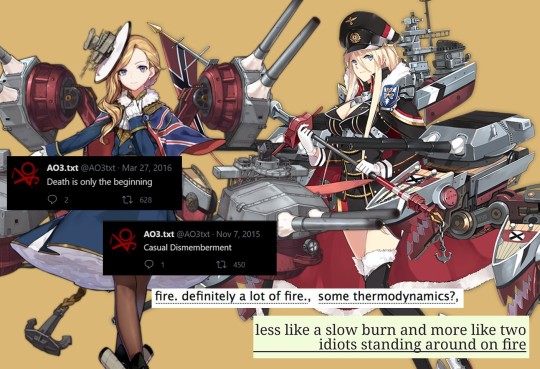


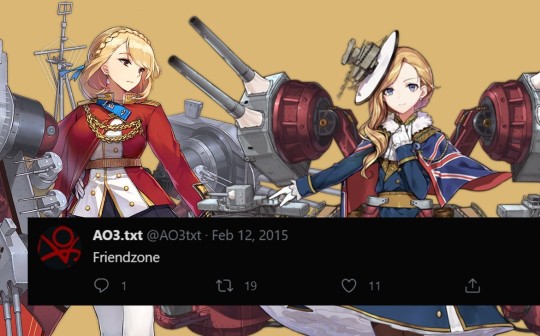
#azur lane meme#hms hood#kms bismarck#kms tirpitz#hms prince of Wales#kms prinz eugen#hms victorious
45 notes
·
View notes
Text

"Eugen, what is this?"
185 notes
·
View notes
Photo

prince/prinz
10 notes
·
View notes
Link
Chapters: 4/4
Fandom: 碧蓝航线 | Azur Lane (Video Game)
Rating: Explicit
Warnings: No Archive Warnings Apply
Relationships: Akashi/Shiranui (Azur Lane), Enterprise/New Jersey (Azur Lane), Jean Bart/Dunkerque (Azur Lane), Prince of Wales/Prinz Eugen (Azur Lane), Implied/Mentioned:, Akagi/Enterprise (Azur Lane), Victorious/Enterprise/Tirpitz (Azur Lane), Belfast/Enterprise (Azur Lane)
Characters: Akashi (Azur Lane), Shiranui (Azur Lane), Enterprise (Azur Lane), New Jersey (Azur Lane), Jean Bart (Azur Lane), Dunkerque (Azur Lane), Prince of Wales (Azur Lane), Prinz Eugen (Azur Lane)
Additional Tags: Rain, for ch 2:, Fantasizing, Teasing, for ch 4:, Car Sex, Coitus Interruptus, (implied) - Freeform, ch 1 and 3 are gen, ch 2 and 4 are Not, (they're explicit and mature i'd say)
Series: Part 11 of femslash feb 2023
Summary:
four ships on a rainy day.
#fanfiction#ijn akashi#ijn shiranui#akashi/shiranui#uss enterprise#uss new jersey#enterprise/new jersey#entybel#enterprise/akagi#entirvic#mnf jean bart#mnf dunkerque#jean bart/dunkerque#hms prince of wales#kms prinz eugen#prince of wales/prinz eugen#azur lane#azurlane#azln#femslash feb 23
7 notes
·
View notes
Text

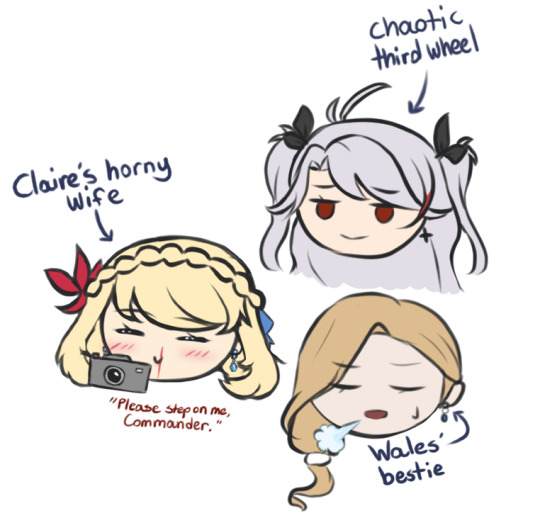
Commander of The Waves (featuring PoW, Eugen, and Hood)
Tweets: Ver. 1 and Ver. 2
Pixiv Post
#Azur Lane#Female Commander#Prince of Wales#Hood#Prinz Eugen#プリンス・オブ・ウェールズ#フッド#プリンツ・オイゲン#アズールレーン#アズレン#碧蓝航线#art#oc#rkgk#not very into muscle but wanted to experiment with it lol
37 notes
·
View notes
Text
Prinz Eugen: I want to wake up with you every day for the rest of our lives
Prince of Wales: I wake up at 4:30 AM
Prinz Eugen: ...
Prinz Eugen: I want to see you at some point every day for the rest of our lives
#HMS Prince of Wales#Prince of Wales#Prinz Eugen#Kreuzer Prinz Eugen#lesbians rule the waves#denmark not straights#azur lane#incorrect azur lane#incorrect quote#incorrect quotes#incorrect azur lane quote#source: internet
51 notes
·
View notes
Text




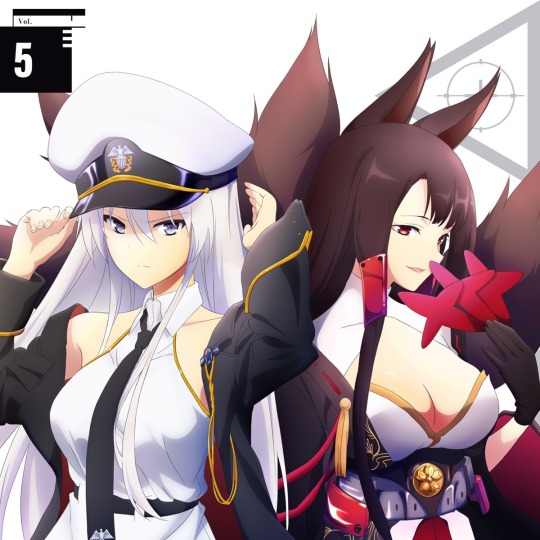
Azur Lane Buddy Character Song Singles Vol. 1 - 5
#azur lane#azur lane anime#yostar#album art#official art#music#anime characters#prinz eugen#prince of wales#queen elizabeth#warspite#cleveland#denver#columbia#montpelier#atago#takao#enterprise#akagi#anime
41 notes
·
View notes
Note
I heard a rumor that The Prince of Wales and Prinz Eugen shared themselves a bed at some point.

“Those are dangerous assumptions.”

“Sie ist viel zu stolz.”
4 notes
·
View notes
Photo

✧・゚: *✧ The Two Princes✧ *:・゚✧
♡ Characters ♡ : Prinz Eugen ♥ Prince of Wales
♢ Video Game ♢ : Azur Lane
☆ Source ☆ : pixiv
.。*゚+.*.。 Art by 迅鱼 。.*.+*゚。.
♥*♡+:。.。 check out r/wholesomeyuri for more wholesome yuri goodness ~ 。.。:+♡*♥
#yuri#GL#prinz eugen#prince of wales#azur lane#prinz eugen x prince of wales#prince of wales x prinz eugen#hugging#height difference#blushing#anime#r/wholesomeyuri#pixiv
133 notes
·
View notes
Video
24 May 1941, Battle of the Denmark Strait, color footage of the German battleship Bismarck firing at the British battlecruiser HMS Hood and battleship HMS Prince of Wales, as captured from the German heavy cruiser Prinz Eugen.
Return fire from both warships can be seen splashing around the German warship, and by the end of the footage Prince of Wales can be seen steaming ahead of the remains of Hood, which exploded after a single hit from Bismarck detonated one of her magazines, sinking less than 10 minutes into the battle.
515 notes
·
View notes